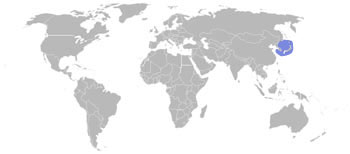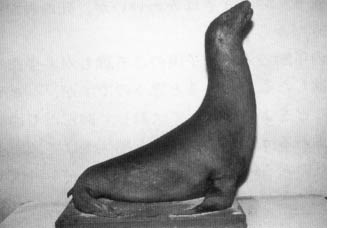
November 8, 2008
This is another guest blog by Brent Swancer.

One of the last known taxidermy specimens of Zalophus japonicus.
The Honshu wolf recently mentioned here is not the only Japanese mammal that has become extinct on the islands due to human influence. The Japanese sea lion, Zalophus japonicus, once roamed the waters around Japan, Korea, the Kuril islands, and the Southern tip of the Kamchatka peninsula.

The specific known range of the Japanese Sea Lion around Japan.
This sea lion reached sizes of up to 2.5 meters and 450 kilograms in weight and was especially numerous in the Sea of Japan, typically breeding on sandy beaches. Although they were often called “black sea lions,” they were not melanistic. Males were typically a dark grey or brown in color and females were a lighter pale grey. A mid-19th century text also described some female specimens as being straw-colored with darker colored underbellies.

In 1850, these sea lions were wrongly described as being Steller’s sea lions, and in later years they were thought to be a subspecies of the Californian sea lion, Zalophus californianus. This taxonomic classification persisted until very recently, when zoologists took a good look at the sea lion’s morphology and DNA.
Through further examination of bones, it was found that the skulls of the Japanese sea lion were proportionately wider than that of the Californian variety. In addition, genetic tests turned up convincing molecular evidence that when taken in conjunction with the morphological differences show that indeed the Japanese variety were a distinct species. The two species are thought to have diverged around 2.2 million years ago during the late Pliocene.
The Japanese sea lion faced a long history of over-hunting and strained food resources due to over fishing. An 18th century Japanese encyclopedia known as the Wakan Sansai Zue described the meat of these sea lions as not tasting very good, but they were harvested for a wide variety of other reasons. The skin was used for oil for lamps, internal organs for Oriental medicine, whiskers for pipe cleaners, and many specimens were collected for circuses. It is also said that soldiers would sometimes use the sea lions for target practice during World War II.
Over 3,200 animals were harvested at the turn of the century, and by the 1930s only a few dozen individuals remained. By the 1940s they were all but extinct.
The last known confirmed sighting was a group of 50 to 60 individuals on a small rocky island known as Takeshima in 1951 and the Japanese Sea Lion was declared extinct by the late 1950s.

The projected range of the Japanese Sea Lion on a world map.

Sightings of the cryptid Japanese Sea Lion continued into the 1960s and 1970s. There was even a juvenile specimen reportedly caught off Rebun Island in Northern Hokkaido in 1974. But none of these cases have been confirmed. Sources such as Wikipedia claim that the 1974 capture was the last confirmed specimen but this is incorrect.
Although the last known sighting was the one on Takeshima Island in 1951, the Japanese Sea Lion was not officially declared extinct until almost 40 years later, with the date fixed in the 1950s when the extinction was considered to have occurred. Therefore, this species was given its extinct status on the IUCN Red List of endangered species in 1990 (despite the fact that it had long been considered extinct by zoologists).
Some people believe that the Japanese Sea Lion might still be holding on out there, but it seems doubtful. There are not many reliable sightings after the 1970s, and there have been extensive marine wildlife studies done in the areas they once inhabited. I tend to think that they likely persisted past the 1950s, but I’m afraid this is one species that might truly be gone now. If they do indeed still exist, I think the most likely places to find the surviving Japanese Sea Lion would be the remote areas of Northern Japan and the Russian Kamchatka peninsula.
About Loren Coleman
Loren Coleman is one of the world’s leading cryptozoologists, some say “the” leading living cryptozoologist. Certainly, he is acknowledged as the current living American researcher and writer who has most popularized cryptozoology in the late 20th and early 21st centuries.
Starting his fieldwork and investigations in 1960, after traveling and trekking extensively in pursuit of cryptozoological mysteries, Coleman began writing to share his experiences in 1969. An honorary member of Ivan T. Sanderson’s Society for the Investigation of the Unexplained in the 1970s, Coleman has been bestowed with similar honorary memberships of the North Idaho College Cryptozoology Club in 1983, and in subsequent years, that of the British Columbia Scientific Cryptozoology Club, CryptoSafari International, and other international organizations. He was also a Life Member and Benefactor of the International Society of Cryptozoology (now-defunct).
Loren Coleman’s daily blog, as a member of the Cryptomundo Team, served as an ongoing avenue of communication for the ever-growing body of cryptozoo news from 2005 through 2013. He returned as an infrequent contributor beginning Halloween week of 2015.
Coleman is the founder in 2003, and current director of the International Cryptozoology Museum in Portland, Maine.
Filed under Cryptomundo Exclusive, Cryptotourism, CryptoZoo News, Cryptozoologists, Cryptozoology, Guest Blog, Mystery Man's Menagerie